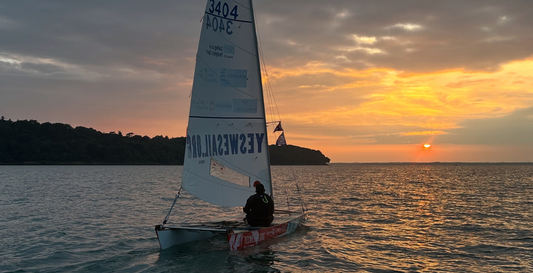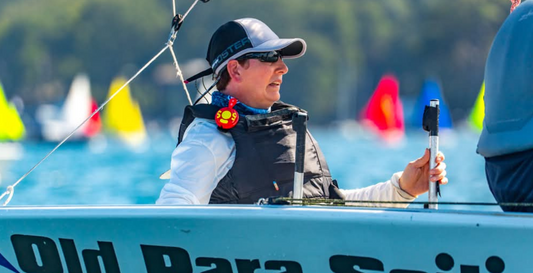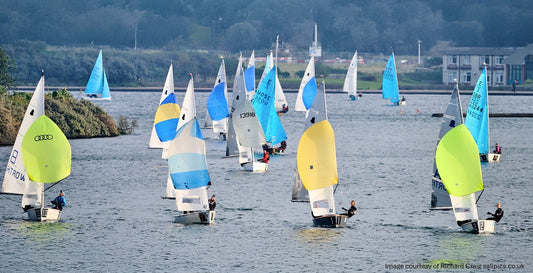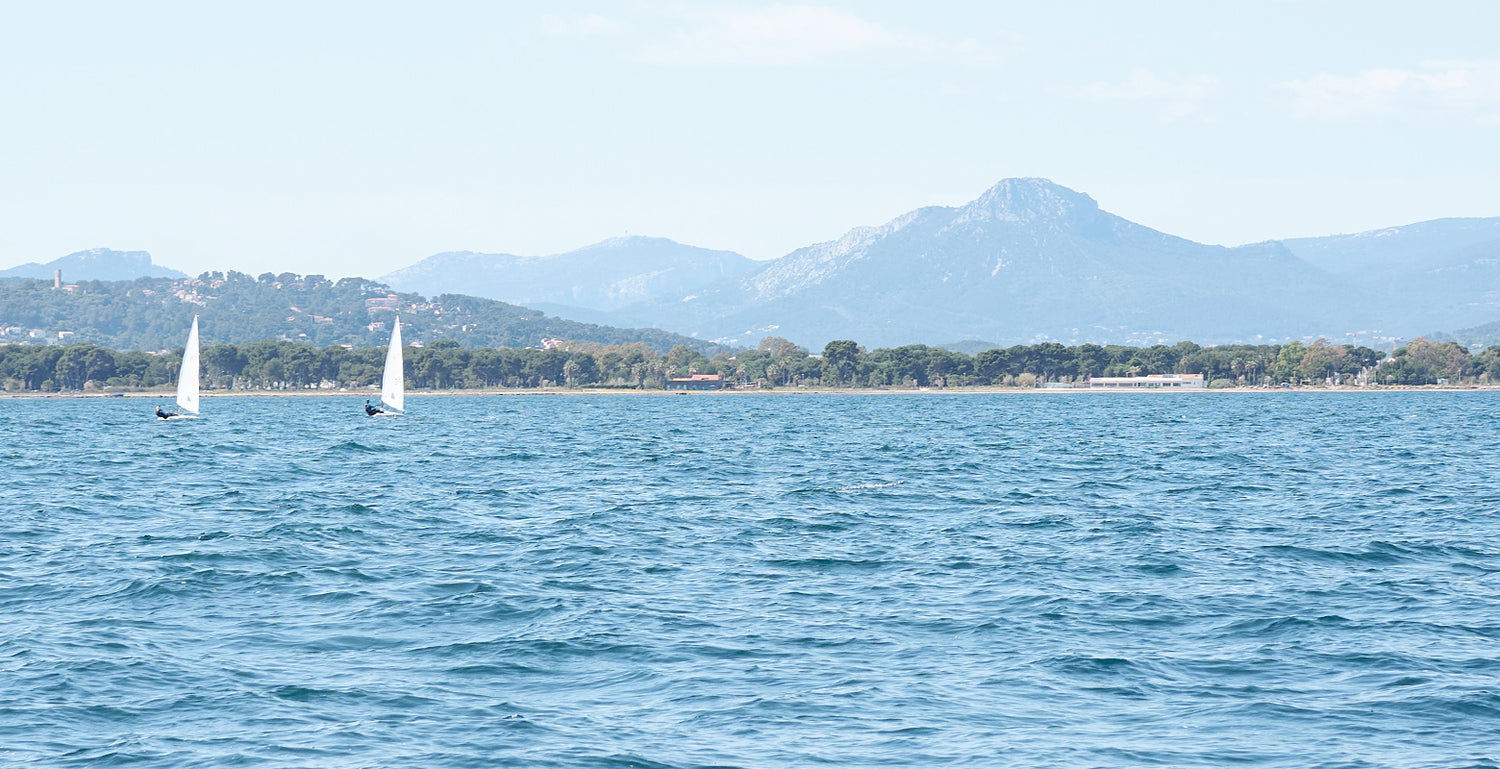
Stories from the water
Blog posts
Redefining Limits: My Journey to Sail Solo Around the Isle of Wight Blind
Written by Dani Anglada Pich
Who I Am
My name is Dani Anglada Pich. I was born in Barcelona in 1986, and the sea has been part of me for as long as I can remember. I first set sail at the age of six in dinghies, and from that very moment I knew: this was where I felt alive. The sound of the wind, the balance of the boat, the salt on my skin—it was home.
At twenty, I was already skippering the ex-Fortuna Light, Spain’s entry in the 1986 Whitbread Round the World Race. That boat carried the spirit of ocean adventure, and being at her helm pushed me to dream even bigger.
Later I studied at the Nautical Faculty of Barcelona, Polytechnic University of Catalogne, becoming a merchant marine officer. My life was all about the sea. And then, in 2018, everything collapsed. An accident on board a merchant vessel left me totally blind.
The first years were brutal. I’ll be honest—I felt like I had lost myself as well as my sight. But slowly, step by step, the sea pulled me back. With rehabilitation, with my family and friends beside me, with professionals and foundations who believed in me, I rebuilt myself. I learned to live again. And more than that—I chose to keep sailing.
In 2024, I founded Yes We Sail, both an association and a start-up, to prove that the sea belongs to everyone, especially those who are told they “can’t.” Sailing became my way of life again, but also my mission: to show that limits are not walls, they are just horizons waiting to be crossed.
Why I Took on the Challenge
Less than a year before the challenge, I said out loud: “I want to sail solo around the Isle of Wight.” At the time it sounded crazy—even to me. But I knew it had to mean something more than just sailing.
During the 37th America’s Cup in Barcelona, I had the support of the organisation and the unconditional encouragement of Grant Dalton. Grant embodies what the Cup is about: perseverance, effort, resilience. I wanted to honour that support. And where better than the Isle of Wight—the very waters where the Hundred Guineas Cup was sailed in 1851, the race that would later become the America’s Cup, and the stage for regattas like the Admiral’s Cup and Cowes Week.
To attempt this circumnavigation blind, in a Patí a Vela—a boat with no rudder, no centreboard, no boom—was my way of tying history to the present. A way to say: the sea is for everyone. And a call: bring sailing back to the Paralympic Games in Brisbane 2032.
Preparation: From Dream to Voyage
To make this real, every detail had to change. My boat, Lady, a Patí a Vela, was built with tactile textures on deck so I could “read” her with my feet and hands. Every rope had a unique feel, so I knew it instantly. I wore a haptic vest that pulsed vibrations for waypoints and wind direction. I studied 3D maps of the island until I could imagine the tides and currents in my head as clearly as if I had seen them with my eyes.
Training in Cowes was intense. The East Cowes Sailing Club opened their doors to me—their slipway, their trust, even their friendship. Magnus Wheatley gave tactical advice, and engineers, volunteers, and sponsors all turned a fragile idea into something seaworthy. And
Lady, built two years earlier with a master boatbuilder and myself, became more than a boat: she was my voice, my balance, my partner.
The Odyssey Around the Island
24 July 2025, 08:01. The cannon of the Royal Yacht Squadron fired. I set off. The first stretch to The Needles was pure joy—12 knots of speed, wind NNW 10–15, and I could feel Lady fly.
Then, silence. At Freshwater Bay the wind dropped, and I had to push eight miles offshore into the Channel to find a breath of air. It took over five hours to reach St Catherine’s Point, sailing downwind with under 10 knots and rolling waves. The Patí doesn’t like that course—it felt unstable, restless under me.
Past the lighthouse, the sea flattened, a NE breeze came in at 12 knots with gusts to 18. For a moment, I thought finally, easier. I was wrong.
After nine hours at sea, past Ventnor and Sandown Bay, came the real trial. The tide turned at low water. Chaos. Gusts slammed up to 28 knots. The hull creaked, the mast groaned, and I thought: What am I doing here, risking everything?
But I stayed. I listened. I focused. I trusted the protocol I’d spent four years building. The Patí speaks if you pay attention—through vibrations, through the surge of the hull, through whispers in the rig. Step by step, I fought on. Thirteen tacks. Twice I was thrown to the deck, struggling to get her steady again. But I carried on.
By sunset, I was spent. Exhaustion, cold, pain. The last miles to Cowes weren’t a fight with the sea—they were a fight with myself. I trimmed the sail, so I didn’t have to move, and locked my focus on the wind, the tide, the rhythm of the boat.
The Finish Line
Finally, the tide lifted me, a soft breeze carried me home. Crossing the line wasn’t the victory I had imagined—it was survival. It was release. It was rebirth.
I collapsed on deck, overwhelmed, and kissed Lady for all she had endured, for bringing me back safe. Two years earlier, with a master boatbuilder, I had begun shaping her. Now, whole and unbroken, she had carried me to harbour. In that moment, I felt nothing but honour. She wasn’t just a boat—she was my companion, my sight, speaking to me mile after mile until we made it home together.
Reflections: What the Sea Taught Me
That day I lived everything: calm and storm, fear and joy, despair and triumph. Times when I doubted. Times when I felt free beyond words. By the end, it all exploded inside me—sadness, pride, exhaustion, happiness, strength.
I realised this: what we call limits are often just perceptions. The sea strips you down until only truth remains. And with preparation, courage, and passion, you can go further than anyone ever thought possible.
Gratitude
None of this would have been possible without those who believed. My deepest thanks to the East Cowes Sailing Club, to Magnus Wheatley, to every volunteer, to my sponsors, and especially to Rooster. The technical clothing and equipment they provided protected me to the very last wave. But more than gear, they gave me something priceless: belief. Belief in people, in dreams, and in the idea that sailing belongs to everyone.
And a very special mention to my main sponsor, Port Masnou and Club Nàutic El Masnou. They’ve been with me from the very start—not only supporting this challenge but building the future of inclusive sailing. They opened their facilities, shared their coaching, and stood behind Yes We Sail with trust and commitment. Without them, this dream would never have left the shore.
Closing Message
To anyone who doubts themselves: remember this. Disabilities are not limits. They are different abilities, different perspectives, different strengths.
If I, without sight, could sail solo around the Isle of Wight, then you too can face your seas—whatever form they take.
This was more than a challenge. It was the beginning of a new horizon: a call for inclusive sailing, for courage, and for the will to believe again.
Hansa World Championships: The Importance of UV Protection on the Race Course
Blog written by Kirsten Pollock, SKUD18 Sailor
Hansa are the largest manufacturer in the world of sail boats used by people with disabilities. The boats are designed to a Universal principle, with weighted keels, that allows anyone, whether young, old, able or with a disability to sail easily and safely, making sailing a very equal and inclusive sport.
Every two years the five Hansa Classes come together for an International and World Championships. The boats are named by metric size, the smallest is the 2.3, then 303 divided into one and two-person fleets, the larger Liberty and finally the fast and powerful Paralympic SKUD18.
The 2025 Hansa Worlds took place at Pittwater, near Sydney, Australia. Sixteen nations, with competitors from Australia, Chile, France, Germany, Great Britain, Hong Kong, Italy, Japan, Netherlands, New Zealand, Poland, Portugal, Singapore, South Korea, Spain and USA took part and, representing Great Britain in the SKUD Class, was me, crewed with top local sailor Brett Pearce who was Australian Reserve Crew for the 2016 Paralympics in Rio. Other illustrious names in the fleet were Dan Fitzgibbon, three times Paralympic Medallist, plus Asia Pacific SKUD Champion Neil Rowsthorne.
The Rooster clothing was brilliant, especially the long sleeved UV top, neck sleeve and cap helped protect me and my crew from the sun. I have fair skin and burn very easily so having the right clothing especially in strong UV conditions makes all the difference. I could focus on sailing rather than having to contend with sunburn etc.
After the regatta I went travelling and Rooster were with me every step or wheel of the way. I spent a few days in central Sydney. I then went to Uluru, from there I went to Port Douglas and went to the Barrier Reef, I wore Rooster kit in the water to protect me from the UV rays. I then went to Melbourne.
My Rooster kit proved to be the ultimate travel companion — keeping me protected, comfortable, and ready for whatever came next. Whether I was sailing in high-performance conditions or exploring some of Australia’s most iconic landscapes, having reliable gear made all the difference. I genuinely wouldn’t travel — or sail — without it.
Supporting Sailing Opportunities for Southport Schoolchildren
Blog submitted by Richard Westlake, West Lancashire Yacht Club
At West Lancashire Yacht Club, we believe sailing should be for everyone — regardless of background or income. That’s why, over the past few years, we’ve worked hard to grow our Outreach Programme, making sailing more accessible to young people in our local community.
In 2024, we were honoured to receive the RYA Sunsail “Funding the Future” Award — national recognition for our grassroots outreach work. It’s a programme built in partnership with local primary schools, including Norwood and Larkfield, right here in Southport.
Through this initiative, we’ve introduced nearly 200 Year 5 pupils to the water — many of whom had never even considered sailing before. With the help of our fantastic volunteers and the enthusiastic support of the schools, every child has been able to take part, regardless of experience or financial circumstance. Teachers have joined in too, showing how sailing can connect people of all ages and abilities.
But this is about more than just one day on the marine lake in the heart of the children's hometown. For us, it’s about building confidence, sparking ambition, and creating real opportunities for young people to progress — whether that’s continuing at club level or one day racing competitively. As a newly recognised British Sailing Pathway Club, we’re committed to helping those journeys continue.
We’re also proud to work closely with Southport schools and with West Lancashire Yacht Club members who give their time, expertise, and passion to support these young sailors. It’s a real community effort — and we’re only just getting started.
This year, we’re excited to be running a raffle alongside our famous 24 Hour Race, helping raise vital funds to support and expand the Outreach Programme, with great prizes from several sponsors. Thanks to the generous support from Rooster, prizes include high-performance kit from their SB1 and Shoreline ranges.
With Rooster’s backing, we’re not just celebrating endurance on the water — we’re investing in a future where more young people can experience the thrill of sailing, no matter their starting point.
Because for us, real endurance isn’t just about sailing non-stop for 24 hours — it’s about building a sport, a club, and a community that lasts a lifetime.
To find out more and follow what West Lancashire Yacht Club are doing, head to their Facebook, Instagram, Tiktok or Website.
Big Dreams, Small Island: My Sailing Journey to the 2023 PanAm Games
Blog submitted by Rooster Rider Scarlett Hadley from St. Vincent and the Grenadines.
Competing in the 2023 Pan American Games in Chile was something I never imagined would be possible so early in my sailing career. Here I was at 16 years old, representing St. Vincent and the Grenadines on one of the biggest stages in the sport. It was also my very first international competition which is crazy to look back on.
Coming from a small Caribbean Island where sailing is not as competitive or recognized, stepping into the competitive sailing world was surreal and inspirational. I was racing against Olympians that I had previously only seen online and looked up to. Suddenly, I was no longer watching them, I was racing against them.
It meant the world to be able to represent my country. To have our flag on my sail and to know I was opening doors for other young sailors at home was what really made every challenge worth it. It pushed me far out of my comfort zone but also showed me how far passion, hard work, and belief can take you.
This experience would've been impossible without the support of Rooster, whose gear made it possible for me to compete at the top level, where before our sailors had little knowledge about the gear needed to perform at the best, especially in the cold conditions in Chile. The support has kept me prepared, whether racing in tropical heat or chilly winds and I’m incredibly grateful. As I anticipate the Junior Pan American Games in August and the Youth World Championships in Portugal this coming December, I'm hoping to be ready with the right equipment, especially a jacket to help with those freezing temperatures between races!
The PanAm Games, which would usually be a later goal for most, was just the beginning for me. I’m excited to keep learning, growing, and hopefully inspiring the next generation of sailors in St. Vincent and the Grenadines.
No Limits: The Joy of Sailing Without Sight
“When I am sailing, I never think about my lack of sight.” These words, spoken by Lucy Hodges MBE, encapsulate the true spirit of Blind Sailing — a world where limitations are left ashore, and the wind becomes their guide.
Sailing Through Barriers: The Power of Using Sign Language
Have you ever wondered what it may be like to sail with no hearing and having to rely on your other senses? For many deaf sailors, sailing may seem virtually impossible due to a multitude of barriers; from everyday sailing to races.
However, through the work of the deaf sailing community, deaf people have gathered together to work through these challenges and obstacles and with GBR Deaf Sailing, we work to influence change amongst local sailing clubs and to build accessible pathways; enabling deaf people to be treated as equal sailors.
You may often wonder, how do deaf people communicate when sailing, or perhaps what can clubs do to be more inclusive?
For deaf people, like any other sensory losses, your other senses are heightened which can be seen as an advantage, a tool within our armour. Deaf people typically have heightened senses with their eyes, therefore when it comes to sailing, they tend to be more observant to their surroundings and may pick out on the smallest of visible changes quicker than others.
When it comes to sailing amongst crews, communication is vital. Many deaf sailors do not sail for obvious reasons with their hearing aid or implants. When sailing in a group of deaf people, there isn’t the ability to speak/shout whilst under sail or in race mode, this can make it extremely more challenging especially if deaf crews use sign language to communicate or perhaps lip read one another. This often means there are times whereby hands need to be freed to sign and you may see the odd rope in the most strangest of places!
As crews, we come up with effective forms of communication that takes some time to learn and to master, for example should crews not be able to gauge a sense of action through the natural art of sailing, there are certain hand-signals or types of taps to the hull used. However each helm, will have different ways of communicating, based on my own helming style, my typical communication methods are;
To obtain an immediate action would be a series of hard bangs to the hull in order to act fast or to get everyone’s attention.
When it comes to a marker and a tack/gybe, a series of three bangs to the hull in a timed sequence; 1 - ready about, 2 - close to mark, 3 - action
Hand signals; A circular motions up in the air with the index finger - to signify the movement of upwards or downwards actions and also the speed of the motion signifies the speed. For example releasing or taking down the spinnaker, a fast clockwise motion would signify a quick release, anticlockwise would mean to take down (opposite direction).
When racing, using numbered signs is key for timed sequences, for example a count down of 5, 4, 3, 2, 1 using your fingers.
Racing for deaf crews can be challenging, however Rooster’s shop enabled deaf crews to purchase limited edition optimum watches which has vibration settings - this is a life saver for deaf sailors.
As you can see there are a number of ways of communicating on board without the use of speech, this list could be endless, however summaries some of the examples when it comes to sailing.
What could clubs do to be more inclusive?
When it comes to races and events, we ask for a time-pace keeper to assist with the time sequence, this enables deaf crews to follow the sequence of a klaxon / horn. This is where someone would signal a 3, 2, 1 before a klaxon / horn in order for the crew to set their timers in line with the sequence.
We also ask for clubs to give considerations to use of flags and communication tools - thinking about the effective uses of these - not all clubs use flags in this way. Clubs are encouraged to work with deaf sailors to make minor tweaks and adaptions - for example a warning signal in order to get ready, using a pre-agreed flag that is waved at the same time as the signal is sounded.
Clubs have opted to use strobe lights as well as klaxon / horns, however the colour and size of the strobe is key in order to aid in the visibility of this.
GBR Deaf Sailing welcome clubs or individuals who want to know more about how to be more inclusive. For more information or tips please contact daniel14clements@gmail.com
Article written by Daniel Clements
GBR Deaf Sailing - Sailor and Committee member
Blood Diamonds
The Red Rhombus or Red Diamond for Women is a hot topic of debate. Is it bad to single out female sailors, making them have to pay for an additional logo from their male competitors? Is it an archaic rule (in some fleets at least) for female athletes that needs to be abolished? Or is it a small token to celebrate female achievement when they’re lapping the rest? This is an especially divisive topic, and I would just like to caveat the following with a note that of all the opinions surveyed, no two people had the same reasons behind their view. Here’s a collection of a few thoughts from both sides of the (of)fence. Firstly, I do definitely understand when women feel they are being singled out – It does happen. Definitely, as a teenager, I was acutely aware of this, and the diamond was just another way for the world to more easily single me out for things I can’t change about myself. At that age, life was difficult enough and trying to not be totally pathetic in a club of big-breeze-loving middle-aged men was totally unattainable… But I can see the flip side of this too. I did a brief stint in an ancient-old 420 and our elderly boat and old sails were previously owned by a male pairing – no diamonds. Getting a set of them gave us a visual validation that we didn’t look like boys anymore… or at least the sails didn’t. I remember feeling almost relieved – it was so nice to be allowed to look discreetly feminine and not Barbie in a boat. Getting a set of diamonds meant we’d made it and we were off to a big event (where we actually needed them) and had overcome so many hurdles to get there. For non-sailing spectators, it’s much easier to identify between classes that might not race together when you can see a tiny red dot or a fleet of dot-less sails from a distance. It’s not so key for amateur sailing but for the sport to gain so notoriety so we might see it live on terrestrial TV like the F1 (I do like to dream!) It’s going to need little steppingstones for new-viewer-accessibility, especially for the non-sailors and the rest of world to get to grips with. At a lower level - a few months ago there was an ILCA qualifier at my local sailing club and I cannot tell you the how inspiring it was to see the diamonds leading the pack. The red dot was the only way we could identify the women ahead of the men and had there been no visual aid to identify them, there’s no way we would have known who was running away with it. Sail numbers are so difficult to read from a distance. On social media, I’ve read parents’ comments about how despicable and degrading the diamond is as it identifies the female sailor as “abnormal”. The language used is rather inflammatory to the point of being offensive. But if displaying a diamond signifies a female sailor, does a lack of diamond display you as a male? It’s not good if you identify as non-binary or prefer not to answer, but then, how would World Sailing and ultimately the IOC deal with this? – There’s a new can of worms to be opened which I’m not sure our RYA would be fully ready for yet… British Cycling certainly weren’t and FINA (world swimming’s governing body) appear to have opted for male, female and open categories in an attempt to be both inclusive and fair… Athletics to follow… At elite level men and women train separately – before the 470 went mixed, the top performing men and women didn’t train together. Not because one sex is better than the other or because ultimately, men and women are in different fleets, but because they have different training requirements.
If we are all to be treated the same, where do we draw the line? On the extreme end of it, we’d all be wearing unisex clothing, riding the same bicycles, no 1st female prizes and no separate qualification quotas for women. Speaking to an ex-Radial (now ILCA6) sailor she was very clear in her mind that women can’t compete at the same level as men in that class and going gender neutral would result in the top 6 boats going to the big regattas all being male. It’s not even because women are less that men - just different and a boat like an ILCA maybe doesn’t serve the female form as well as it does male. It’s not an issue that is specific to the ILCA either. In fact, anything from RS Aero to 29er and beyond seems to have the same issue, based on regatta results at least. Professional tennis has a very clear divide for this – the men play a very powerful game with serve speeds that make your eyes water but the women play a slower, much more technical and tactical game. [Shout out to Andy Murray’s casual feminism!]. Gymnastics has different events for male and female athletes – traditionally, to show off power and strength for a male athlete and grace, elegance and supple-ty for the female athletes. I think we can all agree that men, women and the trans communities are unique and when this comes to sport, there’s a very delicate line to tread between fairness and inclusivity. As the world becomes more aware, will the red rhombus for women remain? Or will it become extinct as we move to a modern age? I can see other sides of the argument and I know how it feels for both sides too… but I couldn’t give you a definitive answer… Only that, at an amateur level, I think we have bigger fish to fry!
From Lowly Lockdown to New Board and Hydrofoil Repair - By Isaac Lines
Early this year I found myself in Portugal training and getting used to the new olympic wind foiling equipment as part of the British Sailing Teams project 24, which had us in perfect conditions daily for hours and hours on the water, the team was making extraordinary progress every day as we found out more and more about maximising the new exciting foiling equipment.
There was always a sense of the worrying progression with the covid-19 outbreak within the uk and surrounding countries to Portugal. Is and the coaches were always keeping a side eye on the trends with the virus and the direction that other countries were heading. But with training to do and Portugal in particular the algarve region to which we were based being researched with extremely low outbreaks. Concerns were minimal in the team there wasn't much thought other than finishing the remaining two weeks of training in Vilamoura and heading back to chilly uk. Wow! How we were wrong. A swift team meeting had our coaches outlining the orders from the RYA and UK government to pull out of Portugal and effectively make a run for the border. With this movie-like panic scene unfolding away from getting ready for another two weeks of training suddenly had us in a mad boat park rush to get all our equipment packed into the RYA team vans and coach boats ready to hit the road the next day. A mad jumble of flights booked and kit packed the following day most us windsurfers were on our way back to uk safety.
The following days had us all back in the uk unpacking our kit back at our main training ground of Portland harbour in the rain and cold feeling rather sleep deprived and a tad disgruntled at our abrupt situational change.
As the dreaded 23rd of march came around I found myself at the beginning of a uk wide lockdown with my two flatmates on portland Jon a fellow team NewWave member and Dan a great friend, 49er sailor and boat builder working the same job as myself. With such a crazy change all three of us being outdoor adrenaline craving hooligans it made for a rather interesting couple of months.
At first it was uncertain for myself having time off my work (a composites and dingy repair workshop on portland) prior to going out to portugal and having the uk lockdown I no longer had a job working there an upsetting moment as i was massively enjoying working and learning every side of composite repair and working around and for the top sailors in the world the workshop going strength to strength with my knowledge i have from my past business prior which was mainly repairing windsurf and surf boards from my home workshop.
The first lockdown was funny knowing my head. I knew I had to keep busy to stay happy.
Quickly turning my flat's balcony into a mancave/workshop. And writing a big old list of everything I needed to fix design and create. From board repairs to custom camera mounts to get new and exciting angles for Team NewWave. There was no shortage of things to make and design this for me was one of the most crucial things to stay positive and focused. Every day I had things which needed the next stage done in lamination or repair; this massively helped keep my hands working.
There was also an aspect of planning which I settled into doing having stepped away from working for my local repairer I knew I wanted my own show a big step in my life but i had so much energy to implement my years in marine repair industry and become my own name in the industry using my strength and client base in the windsurf sector here on portland.
With eyes on getting my own workshop it was a time to learn everything and make all the things I might need going forward so when out of lockdown i'm set to just work and get the business off the ground.
As Well as trying to keep my brain busy, I knew the importance of keeping my fitness up was for staying positive through such an uncertain crazy time. With me and my flatmate Dan being both addicted to challenge lockdown was a perfect time for finding new places in our sufferfest paincave. This was stupidly started one evening with being nominated the run 5 donated 5 challenge the following day me and Dan ran to a rather conveniently placed durdle door a 25km trail run away… and back ending up being around a 54km day out running. This was an incredible challenge bearing in mind me and Dan are keen cyclists so running was never on our radar. In the time of national lockdown it was very easy to stay very comfortable and have no physical battles. So going and putting my body in a place suffering so far away from the norm was incredible learning. There no lying being extremely inexperienced in running let alone this quainity this hurt us both to new levels.
Coming home and barely being able to walk for a few days was an interesting new dynamic to lockdown. With a recovery fairly complete the following week found us back to do it again…. Not sure why at all in hindsight it was a horrific idea this time running to abbotsbury a local village again 25ish kms away and back i'll spare you the details but this was an even harder experience with evermore widened understanding of what a “hard” situation was. Suddenly supermarkets being out of toilet rolls and the harbour being closed for watersports seemed a very light problem in our life when compared to 40 km into our run with no food left.
When looking back on the first lockdown in the uk I took it as a very good time to try new things and learn new places in my head. This gave me time to pause and prep for the next step into business in my life. I'm now running my own business here in Portland specializing in board and hydrofoil repair. With a hectic past 4 months working flat out building a client base workshop and name for myself.
Isaac Now runs a marine and composite repair company, check it out here



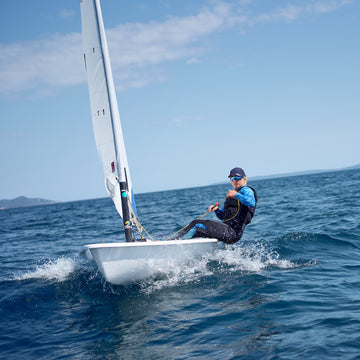
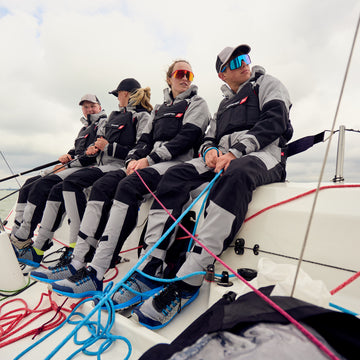
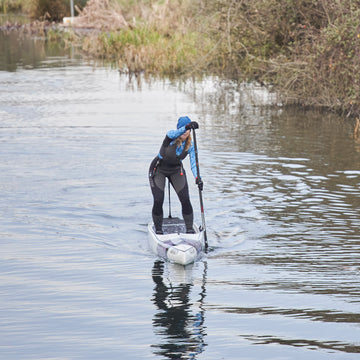
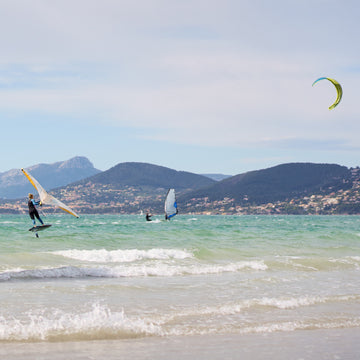
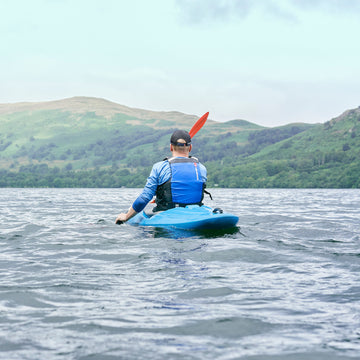
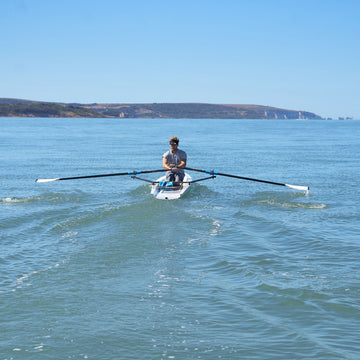
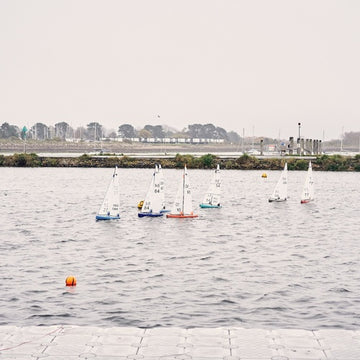
 Select Store
Select Store
 EU
EU
 US
US
